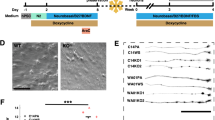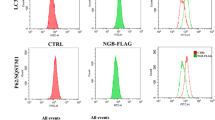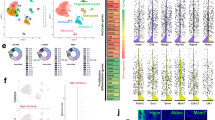Abstract
Disruption of cell–matrix interactions can lead to anoikis – apoptosis due to loss of matrix contacts. Altered fibronectin (FN) induces anoikis of primary human fibroblasts by a novel signaling pathway characterized by reduced phosphorylation of focal adhesion kinase (FAK). However, the receptors involved are unknown. FAK phosphorylation is regulated by nerve/glial antigen 2 (NG2) receptor signaling through PKCα a point at which signals from integrins and proteoglycans may converge. We found that an altered FN matrix induced anoikis in fibroblasts by upregulating NG2 and downregulating integrin α4. Suppressing NG2 expression or overexpressing α4 rescued cells from anoikis. NG2 overexpression alone induced apoptosis and, by reducing FAK phosphorylation, increased anoikis induced by an altered matrix. NG2 overexpression or an altered matrix also suppressed PKCα expression, but overexpressing integrin α4 enhanced FAK phosphorylation independently of PKCα. Cotransfection with NG2 cDNA and integrin α4 siRNA did not lower PKCα and pFAK levels more than transfection with either alone. PKCα was upstream of FAK phosphorylation, as silencing PKCα decreased FAK phosphorylation. PKCα overexpression reversed this behavior and rescued cells from anoikis. Thus, NG2 is a novel proapoptotic receptor, and NG2 and integrin α4 oppositely regulate anoikis in fibroblasts. NG2 and integrin α4 regulate FAK phosphorylation by PKCα-dependent and -independent pathways, respectively.
Similar content being viewed by others
Log in or create a free account to read this content
Gain free access to this article, as well as selected content from this journal and more on nature.com
or
Abbreviations
- ECM:
-
extracellular matrix
- FAK:
-
focal adhesion kinase
- FN:
-
fibronectin
- NG2:
-
nerve/glial antigen 2
References
Kapila YL, Wang S, Johnson PW . Mutations in the heparin binding domain of fibronectin in cooperation with the V region induce decreases in pp125(FAK) levels plus proteoglycan-mediated apoptosis via caspases. J Biol Chem 1999; 274: 30906–30913.
Tafolla E, Wang S, Wong B, Leong J, Kapila YL . JNK1 and JNK2 oppositely regulate p53 in signaling linked to apoptosis triggered by an altered fibronectin matrix: JNK links FAK and p53. J Biol Chem 2005; 280: 19992–19999.
Kapila YL, Wang S, Dazin P, Tafolla E, Mass MJ . The heparin-binding domain and V region of fibronectin regulate apoptosis by suppression of p53 and c-myc in human primary cells. J Biol Chem 2002; 277: 8482–8491.
Frisch SM, Vuori K, Ruoslahti E, Chan-Hui PY . Control of adhesion-dependent cell survival by focal adhesion kinase. J Cell Biol 1996; 134: 793–799.
Ilic D, Almeida EA, Schlaepfer DD, Dazin P, Aizawa S, Damsky CH . Extracellular matrix survival signals transduced by focal adhesion kinase suppress p53-mediated apoptosis. J Cell Biol 1998; 143: 547–560.
Hungerford JE, Compton MT, Matter ML, Hoffstrom BG, Otey CA . Inhibition of pp125FAK in cultured fibroblasts results in apoptosis. J Cell Biol 1996; 135: 1383–1390.
Vuori K, Ruoslahti E . Activation of protein kinase C precedes alpha 5 beta 1 integrin-mediated cell spreading on fibronectin. J Biol Chem 1993; 268: 21459–21462.
Schlaepfer DD, Hanks SK, Hunter T, van der Geer P . Integrin-mediated signal transduction linked to Ras pathway by GRB2 binding to focal adhesion kinase. Nature 1994; 372: 786–791.
Haimovich B, Kaneshiki N, Ji P . Protein kinase C regulates tyrosine phosphorylation of pp125FAK in platelets adherent to fibrinogen. Blood 1996; 87: 152–161.
Woods A, Couchman JR . Protein kinase C involvement in focal adhesion formation. J Cell Sci 1992; 101 (Pt 2): 277–290.
Clark EA, Brugge JS . Integrins and signal transduction pathways: the road taken. Science 1995; 268: 233–239.
Iida J, Meijne AM, Spiro RC, Roos E, Furcht LT, McCarthy JB . Spreading and focal contact formation of human melanoma cells in response to the stimulation of both melanoma-associated proteoglycan (NG2) and alpha 4 beta 1 integrin. Cancer Res 1995; 55: 2177–2185.
Yang J, Price MA, Neudauer CL, Wilson C, Ferrone S, Xia H et al. Melanoma chondroitin sulfate proteoglycan enhances FAK and ERK activation by distinct mechanisms. J Cell Biol 2004; 165: 881–891.
Stallcup WB . The NG2 proteoglycan: past insights and future prospects. J Neurocytol 2002; 31: 423–435.
Midwood KS, Salter DM . Expression of NG2/human melanoma proteoglycan in human adult articular chondrocytes. Osteoarthr Cartil 1998; 6: 297–305.
Tillet E, Gential B, Garrone R, Stallcup WB . NG2 proteoglycan mediates beta1 integrin-independent cell adhesion and spreading on collagen VI. J Cell Biochem 2002; 86: 726–736.
Makagiansar IT, Williams S, Mustelin T, Stallcup WB . Differential phosphorylation of NG2 proteoglycan by ERK and PKCalpha helps balance cell proliferation and migration. J Cell Biol 2007; 178: 155–165.
Barritt DS, Pearn MT, Zisch AH, Lee SS, Javier RT, Pasquale EB et al. The multi-PDZ domain protein MUPP1 is a cytoplasmic ligand for the membrane-spanning proteoglycan NG2. J Cell Biochem 2000; 79: 213–224.
Stegmuller J, Werner H, Nave KA, Trotter J . The proteoglycan NG2 is complexed with alpha-amino-3-hydroxy-5-methyl-4-isoxazolepropionic acid (AMPA) receptors by the PDZ glutamate receptor interaction protein (GRIP) in glial progenitor cells. Implications for glial-neuronal signaling. J Biol Chem 2003; 278: 3590–3598.
Burg MA, Grako KA, Stallcup WB . Expression of the NG2 proteoglycan enhances the growth and metastatic properties of melanoma cells. J Cell Physiol 1998; 177: 299–312.
Ozerdem U, Stallcup WB . Pathological angiogenesis is reduced by targeting pericytes via the NG2 proteoglycan. Angiogenesis 2004; 7: 269–276.
Schaefer L, Macakova K, Raslik I, Micegova M, Grone HJ, Schonherr E et al. Absence of decorin adversely influences tubulointerstitial fibrosis of the obstructed kidney by enhanced apoptosis and increased inflammatory reaction. Am J Pathol 2002; 160: 1181–1191.
Modrowski D, Orosco A, Thevenard J, Fromigue O, Marie PJ . Syndecan-2 overexpression induces osteosarcoma cell apoptosis: implication of syndecan-2 cytoplasmic domain and JNK signaling. Bone 2005; 37: 180–189.
Bi Y, Stuelten CH, Kilts T, Wadhwa S, Iozzo RV, Robey PG et al. Extracellular matrix proteoglycans control the fate of bone marrow stromal cells. J Biol Chem 2005; 280: 30481–30489.
Seidler DG, Goldoni S, Agnew C, Cardi C, Thakur ML, Owens RT et al. Decorin protein core inhibits in vivo cancer growth and metabolism by hindering epidermal growth factor receptor function and triggering apoptosis via caspase-3 activation. J Biol Chem 2006; 281: 26408–26418.
Grako KA, Ochiya T, Barritt D, Nishiyama A, Stallcup WB . PDGF (alpha)-receptor is unresponsive to PDGF-AA in aortic smooth muscle cells from the NG2 knockout mouse. J Cell Sci 1999; 112 (Pt 6): 905–915.
Wayner EA, Kovach NL . Activation-dependent recognition by hematopoietic cells of the LDV sequence in the V region of fibronectin. J Cell Biol 1992; 116: 489–497.
Parsons JT . Focal adhesion kinase: the first ten years. J Cell Sci 2003; 116: 1409–1416.
Mitra SK, Schlaepfer DD . Integrin-regulated FAK-Src signaling in normal and cancer cells. Curr Opin Cell Biol 2006; 18: 516–523.
Lewis JM, Cheresh DA, Schwartz MA . Protein kinase C regulates alpha v beta 5-dependent cytoskeletal associations and focal adhesion kinase phosphorylation. J Cell Biol 1996; 134: 1323–1332.
Chang CC, Campoli M, Luo W, Zhao W, Zaenker KS, Ferrone S . Immunotherapy of melanoma targeting human high molecular weight melanoma-associated antigen: potential role of nonimmunological mechanisms. Ann NY Acad Sci 2004; 1028: 340–350.
Kapila YL, Niu J, Johnson PW . The high affinity heparin-binding domain and the V region of fibronectin mediate invasion of human oral squamous cell carcinoma cells in vitro. J Biol Chem 1997; 272: 18932–18938.
Huynh QN, Wang S, Tafolla E, Gansky SA, Kapila S, Armitage GC et al. Specific fibronectin fragments as markers of periodontal disease status. J Periodontol 2002; 73: 1101–1110.
Dai R, Iwama A, Wang S, Kapila YL . Disease-associated fibronectin matrix fragments trigger anoikis of human primary ligament cells: p53 and c-myc are suppressed. Apoptosis 2005; 10: 503–512.
Nishiyama A, Stallcup WB . Expression of NG2 proteoglycan causes retention of type VI collagen on the cell surface. Mol Biol Cell 1993; 4: 1097–1108.
Leirdal M, Sioud M . Gene silencing in mammalian cells by preformed small RNA duplexes. Biochem Biophys Res Commun 2002; 295: 744–748.
Acknowledgements
We thank Dr. Silvio Gutkind (NIH) for the PKCα cDNA, Paul W Johnson for recombinant FN proteins, and Stephen Ordway for editorial assistance. This study was supported by NIH grants R01-DE13725 (YLK) and R01-CA95287 (WBS).
Author information
Authors and Affiliations
Corresponding author
Additional information
Edited by H Ichijo
Rights and permissions
About this article
Cite this article
Joo, N., Watanabe, T., Chen, C. et al. NG2, a novel proapoptotic receptor, opposes integrin α4 to mediate anoikis through PKCα-dependent suppression of FAK phosphorylation. Cell Death Differ 15, 899–907 (2008). https://doi.org/10.1038/cdd.2008.22
Received:
Revised:
Accepted:
Published:
Issue date:
DOI: https://doi.org/10.1038/cdd.2008.22
Keywords
This article is cited by
-
Neuron/Glial Antigen 2-Type VI Collagen Interactions During Murine Temporomandibular Joint Osteoarthritis
Scientific Reports (2019)
-
CSPG4: a prototype oncoantigen for translational immunotherapy studies
Journal of Translational Medicine (2017)
-
NG2 cells, a new trail for Alzheimer’s disease mechanisms?
Acta Neuropathologica Communications (2013)
-
The progenitor cell marker NG2/MPG promotes chemoresistance by activation of integrin-dependent PI3K/Akt signaling
Oncogene (2008)



